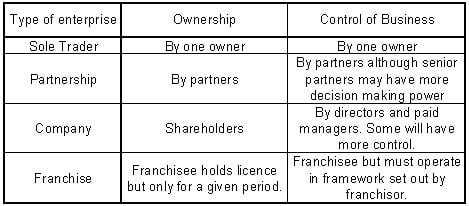
The owner of a business is the person who owns the business – i.e. has put the financial capital into the business and takes out the profit. The controller of the business is the person that makes the management decisions. We can illustrate ownership and control in the following diagram:

You can see that as a business’s structure becomes larger there is a tendency for the control of the organisation to become more widely spread between the owners and those that run the business on a day-to-day basis.
This has been a particular issue in recent years where shareholders in a number of companies are less happy about the way businesses are being run on their behalf. Recent issues have involved directors’ pay and the ethical practices of some businesses.
When directors pay themselves large sums while the results of a company are not very impressive then shareholders are likely to take issue at the AGM and can vote out directors, if this is part of the constitution of a company. Shareholders will also try to influence the ethical practice of the businesses that they own.
Privatisation
Another issue relating to ownership and control has been that of privatisation. A number of industries were formerly in government hands, such as British Rail and British Steel.
When these industries were passed into the private sector the government established regulatory frameworks for these industries. Ownership is passed from the government to private shareholders. Control is passed from state-appointed managers to those appointed by shareholders.
The term privatisation refers to the situation when an industry or organisation moves from government ownership to private sector (shareholder) ownership.
